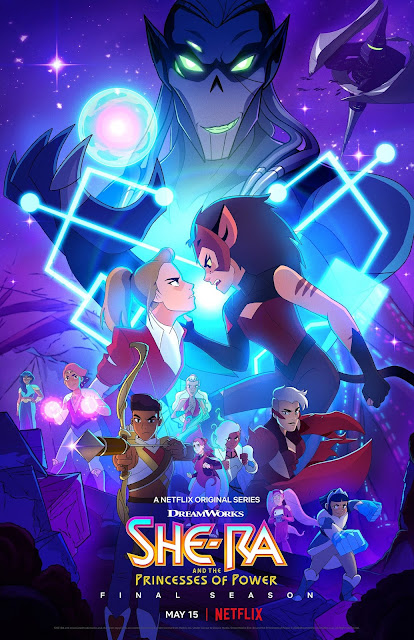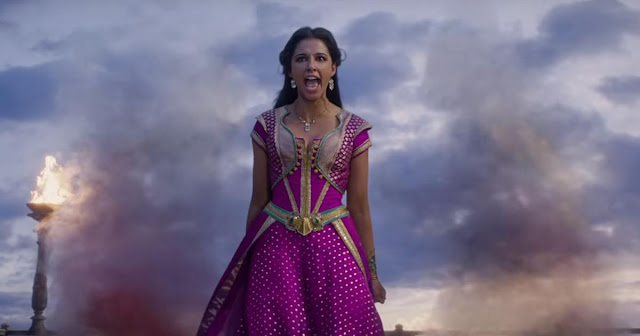The Spirit of She-Ra Lives On!
On September 9, 1985, She-Ra: Princess of Power premiered as a He-Man spin-off with a traditional good vs. evil plot about Adam's twin sister, Adora. At that time, female superheroes and strong women were not seen often on television. Over thirty years later, the tables turned. Now the warrior princess archetype is dominant, while damsels in distress are frowned upon and have become virtually nonexistent in modern media. That makes it the perfect time to reboot this once revolutionary series through an even more contemporary lens. Instead of being a straight action series like its predecessor, She-Ra and the Princesses of Power introduces complex studies of character relationships, fleshing out the two-dimensional heroes and villains from the 1985 series. Most characters in the reboot belong to gender and sexual minorities, making it a beautiful celebration of diversity for a today's audiences. This inspired DreamWorks cartoon concluded today with the fifth and final season streaming on Netflix.
In the '80s and '90s, children's cartoons were fairly cut and dry. There were the good guys, who you loved, and the bad guys, who you loved to hate. Very few people crossed over that line. She-Ra: Princess of Power was no exception with Adora fighting for the Rebel Alliance against the wicked Horde. Yet, the show's pilot movie, "The Sword of She-Ra," began with Adora being brainwashed to think that the Horde was helping the people of Etheria. She made an instantaneous turn from the side of evil to good without ever looking back at the people she once called her comrades. The 2015 version of Adora has a more realistic reaction learning that everything she thought she knew was a lie. Though she understands that Hordak is hurting people, she can't blink away her entire childhood of being raised by Shadow Weaver and being friends with Catra, nor can Catra accept that the person she was so close with for so many years is now her enemy. The emotional heart of She-Ra and the Princesses of Power revolves around the fact that Adora and Catra still care about each other despite fighting on opposing sides, which was solidified in the final moments of the show.
Adora and Catra are not the only characters who struggle to make the right decisions. She-Ra and the Princesses of Power reimagines all of the characters from the original series with diverse body types, personalities, and romantic preferences. The show's five-season run gives it just enough time to flesh out its enormous cast, rounding out with a story arc in the final season that focuses on Netossa and Spinerella, a lesbian couple that had been mostly overlooked throughout the first four seasons. Even Hordak, the static villain of the original series, becomes a complex a fully fleshed-out character by with the reveal that he is an inferior clone who wishes to prove himself as worthy to the true villain of the series, Horde Prime. There were plenty of other characters who switch sides throughout the course of the show as well, especially in the plot-driven fourth season, teaching viewers that no one is truly a good or bad person, even if they have a big poisonous scorpion tail on their back. Entrapta's desire to help her friends despite struggling with social cues can also be interpreted as a positive portrayal of autism.
The ending of She-Ra and the Princesses of Power is similar to that of Tangled: The Series, another princess cartoon that reached its conclusion this year. Both series feature a strong princess with a female friend who feels overshadowed by her and takes dangerous actions to get more attention, only to be won over by the princess's love in the end. In the case of Tangled, Rapunzel was already in a relationship with Eugene that culminated in marriage in the "Tangled Ever After" short released prior to the series, so her relationship with Cassandra could only go so far. In She-Ra and the Princesses of Power, however, Adora and Catra had a lesbian-encoded frenemy relationship since the beginning. Their influence over each other was so powerful throughout the course of the show, especially in the third season, that I don't see how it could have possibly ended any other way than how it did. The conclusion to She-Ra and the Princesses of Power is the ultimate reward to all of the fans who have watched it since the beginning. It delivers everything we could have wanted from a finale and more. Each character's story arc gets tied up with a bow, and it delivers a beautiful message about forgiveness that is perfectly on trend with modern media.
Even though today marks the end of the Netflix reboot of She-Ra and the Princesses of Power, the spirit of the series lives on. After two He-Man reboots, we were long overdue for a She-Ra one, and the timing could not have been better. Girl power is everywhere these days, making the world of Etheria, where women are the stronger sex and princesses are warriors, timely and appropriate for modern audiences. The timeless themes of diversity and acceptance fit just as well into this show as they did for other princess series from bygone eras. With so many Netflix originals popping these days, it would be great to see another reboot or spin-off in the near future. Now that She-Ra has come to a close, Elena of Avalor remains the last animated princess show still airing, primarily due to its inconsistent release schedule this season of only one episode a month. It is only fitting that She-Ra's ending gives way to Elena's since both princesses are voiced by the same actress, Aimee Carrero.












Comments
As for She Ra, it's interesting how much the show accomplished despite only running for 52 episodes over one and a half years.
Now, we know Esteban betrayed his family and was complicit in the deaths of Elena's parents, and Catra opened a portal that almost collapsed reality and led to Angella sacrificing herself. I'm surprised Adora was willing to accept Catra back, and yet Elena isn't open to doing the same with Esteban when what Esteban did was NOTHING compared to what Catra did.
https://mobile.twitter.com/craiggerber_/status/1262937882974511104
Here's some Elena Of Avalor news. There was meant to be a new episode on June 5 called "The Lightning Warrior", but it was moved to late July. Craig Gerber said how the network is planning to burn off the last few episodes of the season (and I assume the series) from late July to August.